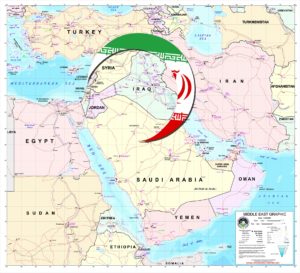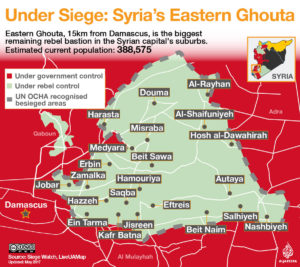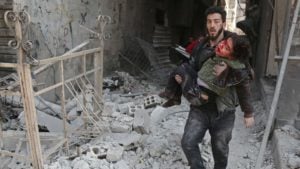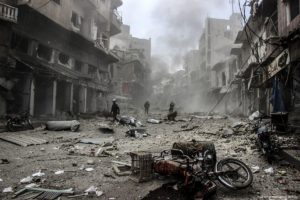
Backed by Russia’s President Putin and Iran’s Revolutionary Guards, the Assad regime has recently made a bloodbath of Eastern Ghouta in Syria. During the past week, in the attacks on the rebel-held enclave near Damascus, upwards of 500 were killed, among them more than 120 children. On February 24, the UN Security Council finally managed to secure a thirty-day ceasefire to create corridors and safe havens for the besieged civilians. Nevertheless, the IRGC chief of staff, Major General Mohammad Bagheri, said that the Assad forces will continue to purge the rebels. All this happens when Syria had become rather calm after six years of hellish civil war, and there were hopes for a truce between the regime and the rebels that would eventually lead to the establishing of a transitional government towards peace.
The question is, why did war flare up in Syria once more? It looks like it has something to do with the Iranian regime’s coming under intense pressure in Iran and the broader Middle East. In the past couple of months the United States and the European Union have been working hard to drag the regime to the negotiating table over its ballistic missile production as well as regional intervention. Saudi Arabia and Israel have also been cooperating to make the noose tighter around the regime’s neck. As such, it seems that the Islamist regime is trying to divert the attention of the international players from itself by stoking fire in Syria and creating a humanitarian crisis. That is what the regime has been doing for the past couple of years all over the Middle East.

That said, I believe there are more fundamental and long-term reasons for the Iranian regime’s bloody intervention in Syria. In this article I am going to shed light on those reasons. In all the years since the 1960s, the Islamists in Iran have been struggling to create a political super-unit out of the Middle East’s Shiite population, which is generally distributed in Iran, Iraq, Syria, Lebanon and Bahrain. The Houthis in Yemen are also distant cousins of the Shiites. The way those countries are set on the map of the Middle East can be regarded as a curve that goes from Iran in the northeast to Lebanon in the southwest. That curve is called the Shiite Crescent. If we take a closer look at the map, we can see that Syria is located right in the middle of the curve. As such, it constitutes the most strategic point on the crescent. If Syria falls, the Shiite Crescent will be divided in half, which is tantamount to its doom. Not only will Syria be snatched from the clutches of Shiite Islamism, but also Hezbollah’s vein of life in Lebanon will be severed. Also, access to the Gaza Strip where most of the jihadi Palestinian groups are stationed will become difficult.
The consequence will be a tipping of the balance of power in the Middle East. After the waning of the Shiite Crescent, the hegemony of the Shiite Camp in the region will break. That will lead to the emergence of the Sunni block headed by Saudi Arabia as the new regional hegemon. The Iranian regime will also lose its “land border” with Israel, which it effectively uses as a significant point of pressure on the Jewish State. If Syria is lost, the Iranian regime will lose access to many strategic sites in the Mediterranean Middle East. As such, maintaining the status quo in the region, most notably in Syria, in the form of “frozen conflicts” is of utmost importance for the Islamic Republic.

It was exactly to maintain the strategic upper hand in the Middle East that the Iranian regime, which finally – albeit begrudgingly – put a lid on its nuclear project, has been fighting tooth and nail to keep Syria. The regime is well aware that it can revive the nuclear project when it finds the propitious moment. In fact, this is not the first time that the regime shelves its atomic ambitions only to produce them at a later time. The Iranian regime started its atomic project in the late 1990s. When President Gorge W. Bush invaded Iraq and toppled Saddam Hussein, the mullahs realized that they can be the next target. As a result, they put an immediate halt to their atomic shenanigans. However, as soon as the American presence in Iraq started to dwindle, the centrifuges began to roll in Iran, this time faster than before. Although the 2015 Nuclear Deal is said to have stemmed the Iranian regime’s atomic ambitions, there is indeed no clear evidence that the ayatollahs are really complying with the terms of the deal.
All in all, the Iranian regime has been using the atomic thing and the deal as a red herring to keep the West busy while it has been expanding the Middle East’s arc of crisis” through sectarianism and conventional warfare. And that is where Syria comes in. The strategic importance of Syria for the Iranian regime is such that once Mehdi Ta’eb, the Supreme Leader’s Special Envoy to the Revolutionary Guards, called it the “35th province of Iran” and said that protecting it was more important than protecting Khuzestan, the oil-rich province in southwestern Iran which used to be a major theater of conflict during the Iran-Iraq War (1980-1988). That is why the Guards, who have been giving blood as well as squandering the wealth of the nation to uphold the Butcher of Damascus, will go sore if Syria falls.

From yet another perspective, the preservation of the Shiite Crescent is crucial for the regime in connection to its standing in Iran. In that respect, the regime’s peculiar Islamist ideology must be taken into account, for its regional imperialism is in many ways a projection of its domestic totalitarianism, both of which feed each other. To clarify, the classic forms of imperialism that had their roots in Western democracies would not necessarily burden their mother nations with the unsavory aspects of imperialism. That is, the imperialists could be imperialists overseas while democracy was flourishing at home. The Islamist regime in Iran, however, is a totalitarian imperialist power that projects its oppressive ideology in all spheres. In fact, the regime is at its cruelest at home when it is at its strongest abroad. In that regard, the Islamist regime can be said to have even surpassed the Nazis. On the other hand, if the regime is pushed out of the region, it is likely to melt down inside Iran. That is why dismantling the Shiite Crescent constitutes first step for the establishment of peace and stability in the Middle East. All the same, it remains to be seen whether the Islamist regime will come back to the negotiating table with a whimper or a bang.